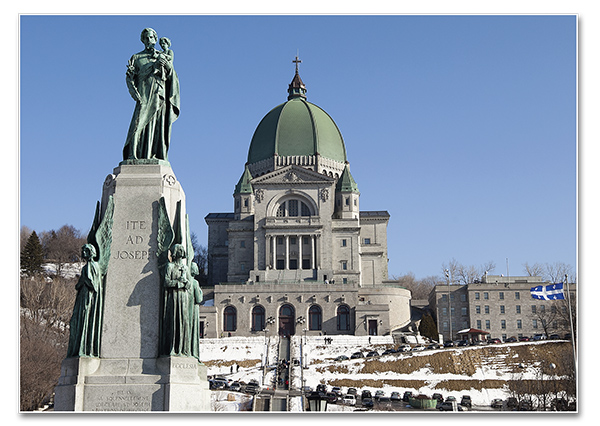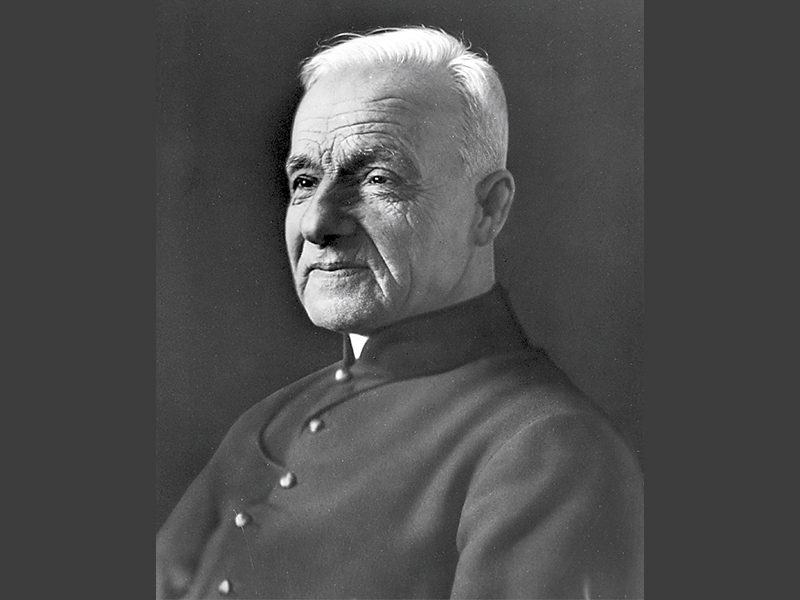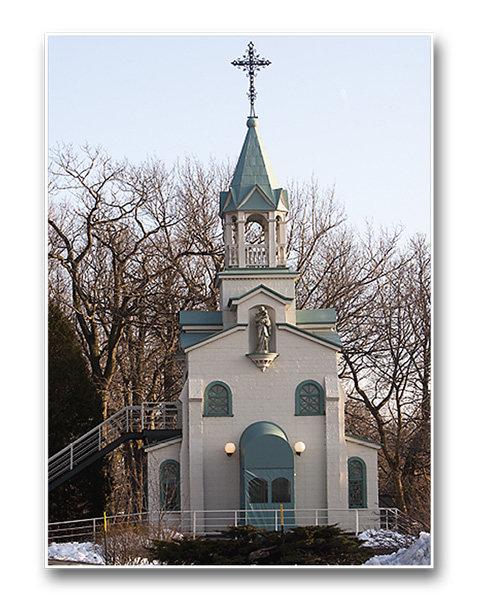Humble religious and simple college porter, he worked thousands of cures and conversions through the intercession of St. Joseph, and built the world’s largest church in his honour.
The news rippled up and down the street: “Brother André is in the neighbourhood visiting a sick woman!”
Doors flew open and children dashed out; families stepped onto porches; the sick were brought, and soon a small crowd gathered around a tiny, white-haired man with sparkling eyes, who moved with difficulty, but had a warm smile for everyone.
He paused to firmly press the hand of a young man and say: “Don’t worry, things are going to be all right.” Further on he lifted an eyebrow with the question, “Do you have faith that St. Joseph can cure you?” His feeble voice was affectionate: “Courage! Have confidence in St. Joseph!”
Before leaving, he had a final word for old and young alike, “Keep on praying!”
As they pulled away, his driver murmured: “It’s like a scene from the life of Our Lord—everyone rushing forward begging favours and cures!” Brother André replied with simplicity, “Perhaps…but God is surely making use of a very vile instrument.”
Despite the stir he caused, Brother André was always little in his own eyes. His favourite spot in the church he built was behind the main altar where he could pray for hours unseen. Once, when a homilist praised “the venerable old man who presides over this shrine,” Brother André was radiant. “How well he preached about St. Joseph!” On another occasion, he told his confreres: “I got into Jersey City just as they were holding a very fine procession—must have been some big local feast,” not realizing that the occasion was a big American welcome—for him!
“I am sending you a saint”
Alfred—his baptismal name—was born into a large and poor family on August 9, 1845, in Saint-Grégoire d’Iberville near Montreal. He was a sickly child and illness would accompany him throughout life.
Some biographers suggest that he identified with St. Joseph because his father had been a carpenter. Be that as it may, it seems that the Carpenter of Nazareth had an eye on the pious lad, as revealed in a rare glimpse into his youth. One day, while working in the fields, Alfred leaned against his rake and asked St. Joseph where he would die. Mystically, a large stone building with a cross atop loomed before him—a glimpse of the church he would one day build in his honour.
But he would travel a winding road beforehand. He tried his hand at various professions, but his health always let him down. At 20 years old he left for the United States, searching for work in the textile mills of Connecticut, but he returned some time later when it became obvious that he was not cut out for such labour.
The village priest, noticing the youth’s virtue, uprightness and constancy, identified an authentic religious vocation and steered him toward the Congregation of Holy Cross—a teaching order newly founded in France by Bl. Basile Moreau that had settled across from Mount Royal. He sent ahead a letter introducing the simple and illiterate candidate, “I am sending you a saint.”
Model of the congregation
Alfred lived up to all expectations, raising the standard of conduct in the novitiate. He soon learned to read and could recite the Passion account from all four evangelists by heart. Meditation on Christ’s sufferings was a pillar of his spirituality: “If we thought that sin crucifies anew Our Lord, ours would be real prayers,” 1 he said. But his presence was jovial and comforting. “Try not to be sad,” he would urge his brothers, “it is good to laugh a little…”
As he neared the end of his novitiate, he feared denial to religious profession because of his health. But after appealing to Bishop Ignace Bourget of Montreal, he duly professed temporary vows on August 22, 1872, receiving the name Brother André, and the assignment of college porter.
Proving his gratitude to all his benefactors and especially St. Joseph—who he had felt would fortify him for his life’s mission once he found it—he exceeded all the demands of a doorman, keeping impeccable order, delivering mail, and running a thousand errands. He spoke French and English and had a knack for putting others at ease and making their concerns his own. He became the model “calling card” of the congregation.
Later in life he quipped, “When I joined this community, the superiors showed me the door and I remained there for forty years.” 2

Numerous, well-documented cures
His healing gift began surfacing about five years into religious life. One day, he looked in on a fevered, bed-ridden student, and told him to go outside and play, since he was in perfect health. The lad did just that—to the consternation of the doctor on call.
On another occasion, when the father of two students brushed past the porter with a strained expression, Brother André scurried after him and asked him what his worry was. The poor man explained that his wife was suffering from paralysis. “Maybe she’s not as sick as you think,”said the saint. At that moment—miles away—the woman stepped out of bed entirely cured.
Alongside these cures, Brother André carried out a discreet apostolate, recommending confident, persevering prayer and alternately suggesting novenas, applying the oil from a lamp that had burned before a statue of St. Joseph, or holding a medal of the saint, saying, “such things are acts of love and faith, of confidence and humility.”
He always made it very clear that it was the “good God” who worked the miracles and St. Joseph’s prayers that obtained them. “I am only the little dog of St. Joseph,” he said humbly. 3
One day, as Brother André was on his knees scrubbing the front hallway of the school, a woman with crippling rheumatism, supported by two friends approached him and asked his intercession for a cure. With a puzzled expression he said, “I believe you could walk on your own if you really tried. Why not go as far as the chapel and see?”
She did so, and returned home walking normally, shedding tears of gratitude.
When the flow of visitors began disrupting college life, Brother André transferred his ministry to a nearby bus station. Hearing this, the Archbishop asked his superiors what he would do if ordered to stop the miracles. Upon being told that he would obey blindly, he replied, “Then let him alone. If the work is from God, it will continue; if not, it will crumble away.” 4
Physical and spiritual cures continued in torrents. More than four thousand documented pages were collected during his beatification process.
A typical example of the miracles that filled his day is the story of a young man who had the skin seared off his face in an industrial accident, endangering his eyesight. He ran in search of Brother André only to be told that he was ministering to a cancer patient and that others were waiting. But just then, Brother André unexpectedly appeared on the scene and, without having heard the youth’s story, said: “Who said you’re going to lose your sight? You have confidence in St. Joseph’s intercession? Good!”
He then gave the man detailed instructions. “Go to the church, attend Mass, go to Communion in honour of St. Joseph, and continue your remedies. Add to them a drop of oil of St. Joseph, and make the following invocation: St. Joseph, pray for us. All will go well. Have confidence!”
The man did exactly that, and the next day the scarred flesh lifted off like “leaves of cellophane.” Entirely cured, he returned in gratitude.
“Thank St. Joseph,” was the saint’s simple reply, “and, continue to pray!”
The waitress at the local restaurant could barely believe that this was the same young man she had seen so badly disfigured a few days ago and told the impressive miracle to all who would listen.
A church for St. Joseph
A holy desire blazed in the soul of the little porter as he went about his daily tasks, but he simply prayed about it, awaiting the right moment. When a fellow religious told him about a strange occurrence in his cell—his statue of St. Joseph seemed to keep turning to face Mount Royal—Brother André was gratified. He said it was not strange at all; it was a sign that St. Joseph wanted to be honoured with a church on the mountain.
He “seeded” the mountain with medals of St. Joseph, and in 1896 the Order bought the land—mostly to avoid neighbours building on the prime real estate. Brother André was permitted to place a statue in a rock-niche, and it attracted thousands of pilgrims.
A small chapel was built from $200 collected from his five-cent haircuts. He also raised funds by placing a tray of “offerings for St. Joseph” at the foot of a statue of the saint, and even obtained donations from contacts in the United States.
In 1904, a small Oratory to St. Joseph was built, consisting of a slightly larger chapel and an office where Brother André took up residence. Thirteen year later, a larger church was completed that accommodated a thousand persons seated, but this, too, became inadequate to serve the influx of faithful.
Construction of the actual basilica—the largest church in Canada—began in 1924. During a lull in the Great Depression in the 1930s, he put a statue of St. Joseph inside saying, “If he wants a roof over his head, he’ll get it.” Construction resumed in two months.
It is noteworthy that while Brother André considered the work a sacred duty, he only gave it the time allowed by obedience, never neglecting his other duties.
A ministry of loving oblation
At the Oratory, his daily ministry to souls and bodies was a loving oblation. He was up at dawn to serve two Masses, and at 8 a.m. his doors opened. In his tiny office-cell, he stood to daily receive 200 to 400 and even up to 700 persons per day.
Visitors seeking sensationalism left disappointed. His advice was simple, sensible, and even perfunctory—aiming more at the cure of souls than bodily ills. Sometimes he limited himself to helping sufferers embrace the will of God, “God will have an eternity to console you for any sufferings here,” 5 he would say.
He encouraged frequent Confession and daily Communion, saying that God can refuse us hardly anything when He is in our hearts. He once commented, “It’s odd…I’m often asked for cures, but very rarely for the virtue of humility, or the spirit of faith.” 6
He showed boundless compassion with those separated from the Church through weakness or ignorance, with emotional retellings of the story of the Prodigal Son. “Comme le bon Dieu est bon,” he would say, “How good is the good God.” But he cut to the root attitudes of rebellion or lack of faith: “Does God owe you anything? If you think so, you had better make your own arrangements with him.” 7
He brought relief to others at a heavy price. At night, wracked by illness and fatigue, he made a slow and painful Way of the Cross, and then knelt for hours with his arms extended in the form of a cross. Often, his bed remained untouched. When a fellow religious pleaded with him to go to bed and offer his sleep as a prayer, he said solemnly, “If you knew the state of those who ask my prayers, you wouldn’t suggest that.” 8
First posthumous fruits
The people loved the kindly white-haired man and begged him not to leave them. But at 92 years of age, death was approaching and he gently consoled them with the truth that if one can do good on earth, he can do far more in Heaven.
On January 6, 1937, the main Montreal newspapers carried the sad headline: “Brother André is Dead” mobilizing a record-breaking crowd that snaked up Mount Royal in the sleet and snow to bid the wonderworker farewell. Mourners arrived by plane and train. The oratory overflowed with a pious multitude. Penitents streamed to confession. A calculated one million people climbed the mountain to the sanctuary, to take their leave of the humble man whose only ambition was to serve God in the utter simplicity of religious life.
These were the first posthumous fruits of the holy lay brother, who, on the 17th of this month will be declared the first saint of his Order as well as the first Canadian-born male to be raised to the honour of the altars.
* * *
Brother André did not live to see the completion of the basilica in the ’60s, nor the fulfilment of a long-held desire to see a large Stations of the Cross erected in the gardens to spread devotion to the Passion of the Redeemer.
But it is impossible not to feel his presence on the spacious grounds, and in the enormous church that attracts three million pilgrims annually and testifies to the grandeur and intercessory power of the Patron of Canada and the Universal Church.
There is a large statue of St. Joseph holding the Christ Child flanking the stairs beckoning pilgrims in. Carved in stone on its pedestal are words which somehow evoke the simple wisdom and boundless faith of the little brother lying in the crypt: “Ite Ad Joseph—Go to Joseph.” ◊
Notes
1 FERGUSON, John. The Place of Suffering. London: James Clarke and Co., 1972, p.115.
2 BALL, Ann. Faces of Holiness. Huntington, (IN): Our Sunday Visitor, 2001, p. 54.
3 KYDD, Ronald. Healing Through the Centuries. Peabody (MA): Hendrickson, 1998, p.85.
4 BALL, op. cit, 57
5 TREECE, Patricia. Nothing Short of a Miracle. New York: Doubleday, 1988, p.74.
6 O’MALLEY, Vincent. Saints of North America. Huntington, (IN): Our Sunday Visitor, 2004, p. 26.
7 KNOWLES, Leo. Modern Heroes of the Church. Huntington (IN): Our Sunday Visitor, 2003, p.82.
8 TREECE, op. cit, p. 75.













